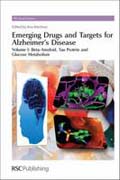
Alzheimer's disease (AD) is the most prevalent neurodegenerative disorder in the elderly. The Bloomberg School of Public Health recently estimated that over 26 million people were living with AD in 2006 and that the number will grow to 106 million by 2050. Interventions that delay onset by just one year could reduce the 2050 figure by 12 million. This demonstrates the importance and social need of finding an effective therapeutic intervention. Both volumes gathertogether some of the most promising examples of drugs now in pharmaceutical development, and new targets currently going through a validation process. It describes the discovery and development history of the disease modifying therapeutics most likely to reach the Alzheimer's market in the next few years. It will be of interest to both those working in the pharmaceutical industry and inacademia from graduate level onwards. ÍNDICE: VOLUME 1; Beta-Amyloid as target; Chapter 1: The amyloid hypothesis of AD and prospects for therapeutics; Chapter 2: Targeting Alzheimer's ?-Secretase: Genetic and Chemical Modulation; Chapter 3: Cholesterol and AD: the molecules, the targets; Chapter 4: The Bimodal Features of Butyrylcholinesterasein Cholinergic Neurotransmission and Amyloid Suppression; Chapter 5: Scyllo-inositol, a potential therapy for Alzheimer's disease; Chapter 6: Immunotherapeutic strategies toward treatment of AD; Tau protein as target; Chapter 7: Alzheimer Neurofibrillary Degeneration: Pivotal Role and Therapeutic Targets; Chapter 8: Multiple roles of glycogen synthase kinase-3 in AD; Chapter 9: Tau protein kinases inhibitors: from the bench to the clinical trials; Chapter 10: Activating PP2A as a therapeutic intervention strategy in AD; Chapter 11: Rationale for tau aggregation inhibitor therapy in Alzheimer's disease and other tauopathies; Glucose Metabolism as target; Chapter 12: Insulin Insulin Resistance and neurodegeneration: Type 2 versus type 3 diabetes mellitus; Chapter 13: Insulin-like Growth Factor I as a disease-modifying therapy in Alzheimer's disease; Chapter 14: Ketone bodies as a therapeutic for Alzheimer's disease; VOLUME 2 Neuronal Plasticity as target; Chapter 15: Regeneration of Degenerated Brain: A Promising Therapeutic Target; Chapter 16: Promoting synaptic resilience inAD patients through PDE inhibition; Chapter 17: A new generation of non invasive NGF-based therapies for Alzheimer's disease; Chapter 18: Possible clinicalapplications of stem cell strategies in AD therapies; Neuronal protection as target; Chapter 19: Targeting Oxidative Mechanisms in Alzheimer Disease; Chapter 20: Davunetide (NAP) Pharmacology: Neuroprotection and tau; Chapter 21: Targeting NF- B inflammatory and pro-survival signaling in AD; Chapter 22: PPAR in Alzheimer's disease; Miscellaneous targets and strategies; Chapter 23: Serotonin 5-HT4 receptors as pharmacological targets for the treatment of Alzheimer's disease; Chapter 24: Liver X Receptors as potential therapeutic target for AD; Chapter 25: Discovery of memoquin, a multi-target-directed ligand for the treatment of Alzheimer's disease Chapter 26. RNA interference of genes relatedto AD B. Nawrot Chapter 27. Medicinal plants, phytochemicals and Alzheimer's Disease D. Kennedy
- ISBN: 978-1-84973-045-7
- Editorial: Royal Society of Chemistry
- Encuadernacion: Cartoné
- Páginas: 529
- Fecha Publicación: 31/05/2010
- Nº Volúmenes: 2
- Idioma: Inglés
